Former fashion marketer Hsing-ju Lin (林倖如) wrote a master’s thesis entitled “Stylistic Change in Women’s Footwear” at the University of Leeds and enjoys poring over books about the history of shoemaking. Lin’s interest in shoes, however, is not purely academic. Her year-old brand Liebe Hsing is dedicated to creating stylish women’s footwear while drawing attention to traditional shoemaking in Taiwan.
Once an important part of the export industry, the number of craftspeople who make shoes by hand began to decline sharply in the mid-1980s after many jobs were outsourced to China and Southeast Asia. All of Liebe Hsing’s colorful, classic designs are produced by the Juisheng Shoemaking Center (瑞晟鞋樣中心), a tiny Greater Taichung workshop run by Lu Kuang-mao (呂光茂), who has over 30 years of shoemaking experience.
Traditional shoemaking “is a part of Taiwan’s culture. I’m still a new brand, but I’ve already thought of how to bring it forward to a new generation,” says Lin, adding that her goal is to make footwear that will last for years.
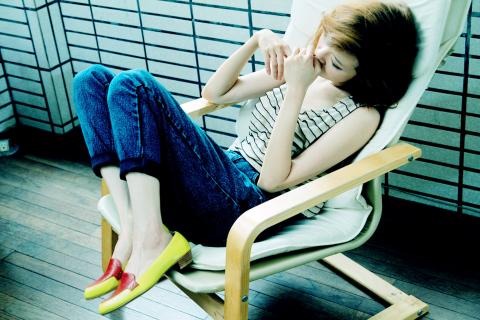
Photo Courtesy of Liebe Hsing
“My challenge is creating a design that people will look at in three decades and still want to use because it looks contemporary and not outdated,” she says.
Liebe Hsing (the name is a combination of the German word for “love” and the first character of Lin’s given name) footwear, which ranges in price from NT$3,480 to NT$7,280 for a pair of lace-up boots, is designed to flatter a wide variety of body types and can be custom ordered. The back of a magenta suede lambskin sandal is carefully sculpted into a sexy curve that gracefully accentuates the wearer’s ankle, while the straps on a pair of classic Mary Jane high heels dip into a gentle “v” over the instep to create the illusion of longer legs.
Lin avoids sequins and rhinestones because the glue used to attach these embellishments damages leather. Instead, she adds visual interest with unusual color or texture combinations, thoughtfully placed seams and finishes that highlight the leather’s natural grain. Hidden details include narrow edgings around innersoles in a color that contrasts with the shoe’s exterior.
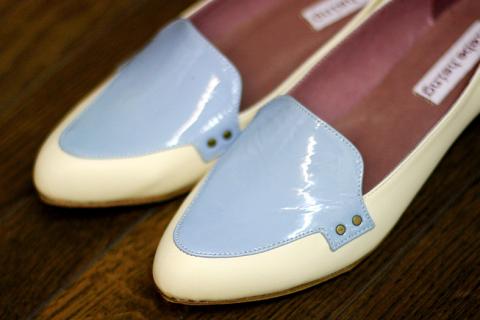
Photo: Catherine Shu, Taipei Times
“I don’t like using a lot of bling because I think they take away from the wearer’s own light,” says Lin, who keeps inspiration scrapbooks filled with photos from fashion blogs like The Sartorialist (www.thesartorialist.com) and magazines like Elle Decor. Her frequent travels (Lin tries to go abroad once a year) also influence her designs: The sweeping lines of Stockholm sailboats and yachts inspired several sandals in her latest collection.
Lin’s emphasis on comfort and wearability is influenced in part by her mother, she says. The two women wear the same shoe size and when Lin left home to attend high school in Changhua County, she bought footwear to send back to her mother in their small hometown in Yunlin County, which only had one shoe store.
“My mom’s feet were always very delicate and she had to buy well-made shoes. She got blisters easily from fake leather, especially during the summer,” Lin says. “That’s when I started to see the difference quality makes.”
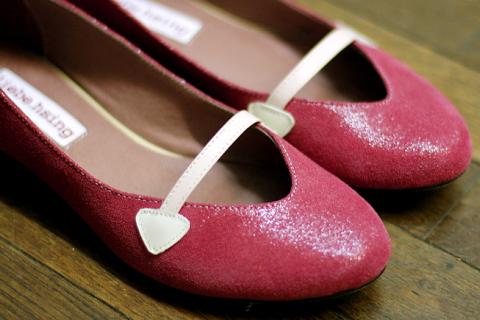
Photo: Catherine Shu, Taipei Times
Lin, who earned a certificate in shoemaking from the Footwear and Recreation Technology Research Institute (台中鞋技中心) in Taichung, has exacting standards for the animal skins she orders from a Taiwanese supplier: Cow leather has to be 1.2mm thick, lambskin just 0.6mm. She wears all of her shoe prototypes to make sure they are comfortable and is frank about the potential shortcomings of shoes made by hand.
Because the leather upper is hammered to the sole by hand, the join between the two parts is less uniform and sleek than one that has been pressed together by a machine. Traditional techniques, however, allow shoemakers to work with more delicate leathers like lambskin, add hand-tooled designs, and conduct thorough quality checks after each step of the manufacturing process to ensure that all components are securely fastened together.
Before agreeing to work with Lin, who at that time had little shoe design experience, Lu grilled his potential client for almost six hours about her business plans and goals.
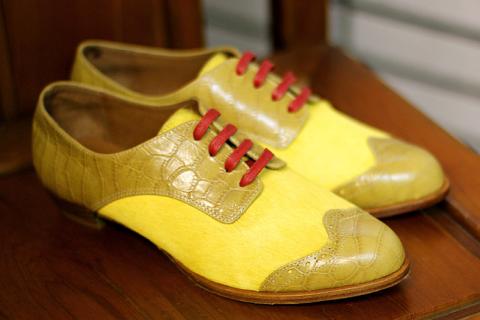
“Shoemaking is not an easy business. It takes a lot of work, you need to understand footwear construction and if you make limited quantities, the production costs are high,” Lu said during a break at his workshop.
Lu usually works with two to four other shoemakers. On a recent day, two women carefully cut and joined leather pieces, making sure the line of stitching was just one millimeter away from the seam. Lu painstakingly hammered the body of a red lambskin high heel to its sole, steadying a heavy plastic last in his lap. On average, he says, each of the workshop’s shoemakers completes two pairs per day.
“Their skills are not in their machines, it is in their hands,” Lin says. “I want people to see the amount of detail these artists can put in each pair of shoes.”
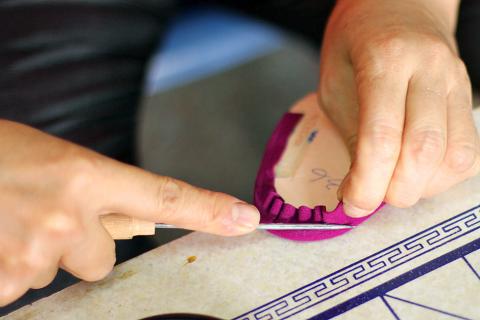
Photo: Catherine Shu, Taipei Times
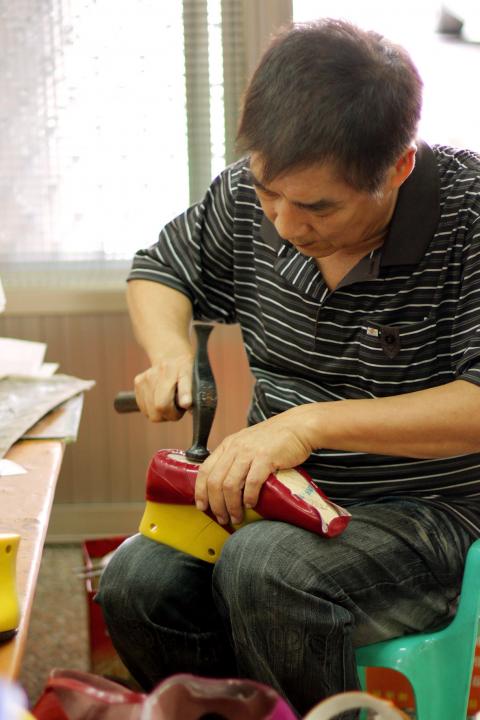
Photo: Catherine Shu, Taipei Times

Exceptions to the rule are sometimes revealing. For a brief few years, there was an emerging ideological split between the Democratic Progressive Party (DPP) and Chinese Nationalist Party (KMT) that appeared to be pushing the DPP in a direction that would be considered more liberal, and the KMT more conservative. In the previous column, “The KMT-DPP’s bureaucrat-led developmental state” (Dec. 11, page 12), we examined how Taiwan’s democratic system developed, and how both the two main parties largely accepted a similar consensus on how Taiwan should be run domestically and did not split along the left-right lines more familiar in

As I finally slid into the warm embrace of the hot, clifftop pool, it was a serene moment of reflection. The sound of the river reflected off the cave walls, the white of our camping lights reflected off the dark, shimmering surface of the water, and I reflected on how fortunate I was to be here. After all, the beautiful walk through narrow canyons that had brought us here had been inaccessible for five years — and will be again soon. The day had started at the Huisun Forest Area (惠蓀林場), at the end of Nantou County Route 80, north and east

Specialty sandwiches loaded with the contents of an entire charcuterie board, overflowing with sauces, creams and all manner of creative add-ons, is perhaps one of the biggest global food trends of this year. From London to New York, lines form down the block for mortadella, burrata, pistachio and more stuffed between slices of fresh sourdough, rye or focaccia. To try the trend in Taipei, Munchies Mafia is for sure the spot — could this be the best sandwich in town? Carlos from Spain and Sergio from Mexico opened this spot just seven months ago. The two met working in the

This month the government ordered a one-year block of Xiaohongshu (小紅書) or Rednote, a Chinese social media platform with more than 3 million users in Taiwan. The government pointed to widespread fraud activity on the platform, along with cybersecurity failures. Officials said that they had reached out to the company and asked it to change. However, they received no response. The pro-China parties, the Chinese Nationalist Party (KMT) and Taiwan People’s Party (TPP), immediately swung into action, denouncing the ban as an attack on free speech. This “free speech” claim was then echoed by the People’s Republic of China (PRC),